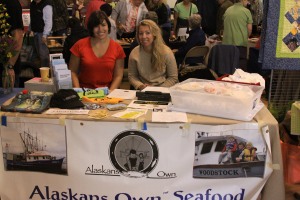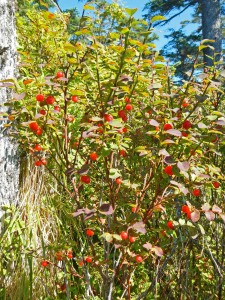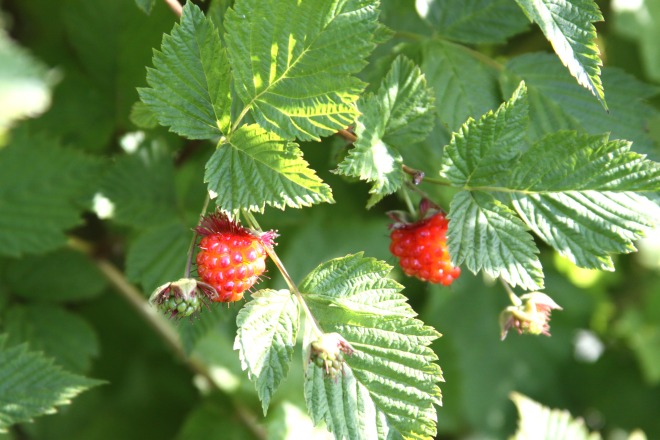
 (This is part of a new series of “Meet your vendors” articles, where Sitka Local Foods Network Intern McLane Ritzel is writing features about our regular Sitka Farmers Market vendors.)
(This is part of a new series of “Meet your vendors” articles, where Sitka Local Foods Network Intern McLane Ritzel is writing features about our regular Sitka Farmers Market vendors.)
Walking past the Alaskans Own Seafood booth at the farmers market, you may have noticed a kind and bright-eyed brunette with black-rimmed glasses selling extra frozen fish from the first community supported fishery (CSF) program in Alaska.
Alaskans Own Seafood is similar to a community supported agriculture organization, or “CSA program,” where on the last Wednesday of each month, they ship fish to participating individuals or families in Seattle, Wash., Juneau, Anchorage, and host a pick-up day for members from Sitka.
 Erin is program coordinator of the Alaska Sustainable Fisheries Trust, but her job entails working with many fishery organizations around Sitka, including the Alaska Longline Fishermen’s Association (ALFA) and their Fishery Conservation Networks (FCN) which engage fishermen in both research and conservation initiatives. Alaskans Own Seafood is part of the Alaska Sustainable Fisheries Trust.
Erin is program coordinator of the Alaska Sustainable Fisheries Trust, but her job entails working with many fishery organizations around Sitka, including the Alaska Longline Fishermen’s Association (ALFA) and their Fishery Conservation Networks (FCN) which engage fishermen in both research and conservation initiatives. Alaskans Own Seafood is part of the Alaska Sustainable Fisheries Trust.
Sitka had always been at the back of her mind as her family took a cruise around Alaska 10 years ago. Despite the fact that they were only in town for one day, they kayaked Sitka Sound and determined it their favorite spot on the trip. Laughing, Fulton says, “I need space. I need more trees than people.”
Most of her family still lives in her hometown of Mahtomedi, Minn., a suburb of St. Paul. Her father is the president of a steel-casting firm and works with the mining industry, and her mother stayed home to raise her and her younger brother, Alex. Alex attended Duke University for graduate school and is now a mechanical engineer for Polaris Industries.
 In 2009, Fulton graduated from St. Olaf College in Northfield, Minn., with two degrees in biology and environmental studies. When she wasn’t studying, she played the contra alto clarinet for the St. Olaf band (“a 90-member family”) when it went on 10-day tours around the United States. Concerned about the environmental effects of their carbon footprint while traveling around the country, Fulton began a carbon-offset initiative for local farmers.
In 2009, Fulton graduated from St. Olaf College in Northfield, Minn., with two degrees in biology and environmental studies. When she wasn’t studying, she played the contra alto clarinet for the St. Olaf band (“a 90-member family”) when it went on 10-day tours around the United States. Concerned about the environmental effects of their carbon footprint while traveling around the country, Fulton began a carbon-offset initiative for local farmers.
After St. Olaf, Fulton attended graduate school at Duke University’s Nicholas School of the Environment and graduated with two master’s degrees in environmental management and forestry. According to Fulton, at Duke, there are 7,000 acres of timberland. Her master’s thesis involved getting carbon-offset, surveying the forest, and examining afforestation, reforestation, improved forest management, and avoided deforestation.
 Having never worked in or pursued an education in the fisheries industry, Fulton took a job in Sitka as a Tongass Forest Resident with the Sitka Conservation Society. She was very interested in resource management in Alaska, because unlike the Lower 48 which is “locked in” with strict laws and regulations, Alaska is an active and dynamic place with constantly changing laws and continued resource extraction. Also, given her background in forest management, she is fascinated by the life cycle of salmon and its role as a “great fertilizer for the trees and forest.” She drove from her home in Minnesota to Alaska with a friend, through the Canadian Rockies and took a ferry to Sitka from Prince Rupert, British Columbia.
Having never worked in or pursued an education in the fisheries industry, Fulton took a job in Sitka as a Tongass Forest Resident with the Sitka Conservation Society. She was very interested in resource management in Alaska, because unlike the Lower 48 which is “locked in” with strict laws and regulations, Alaska is an active and dynamic place with constantly changing laws and continued resource extraction. Also, given her background in forest management, she is fascinated by the life cycle of salmon and its role as a “great fertilizer for the trees and forest.” She drove from her home in Minnesota to Alaska with a friend, through the Canadian Rockies and took a ferry to Sitka from Prince Rupert, British Columbia.
Here in Sitka, Fulton is a member of the local roller derby team Sitka Sound Slayers. Last year, she broke her leg twice, but is looking forward to getting back to the sport stronger than ever this season. And from 9-10 a.m. on Friday mornings, you can catch Erin on KCAW-Raven Radio’s Good Day Show.
Come meet Erin and check out Alaska’s Own at the next Sitka Farmers Market from 10 a.m. to 1 p.m. on Saturday, Aug. 23, at the Alaska Native Brotherhood Founders Hall (235 Katlian St.).
 When people stop at the Sitka Local Foods Network booth at the Sitka Farmers Market to buy produce a common question people ask is where is the food grown.
When people stop at the Sitka Local Foods Network booth at the Sitka Farmers Market to buy produce a common question people ask is where is the food grown.
















You must be logged in to post a comment.